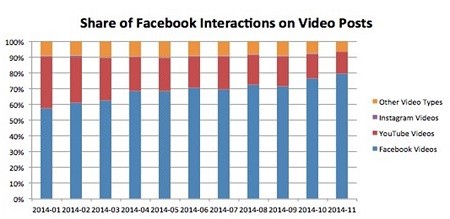Four Reasons to Take Advantage of Facebook's Evolving Video Strategy
 Facebook is investing heavily in its video service, working hard to grow its video reach and ad efficacy. And it's making inroads.
Facebook is investing heavily in its video service, working hard to grow its video reach and ad efficacy. And it's making inroads.In August, Facebook achieved a billion more desktop video views than YouTube, according to comScore, and now serves up more than 3 billion video views every day.
Such a strong upswing of video views on Facebook can be attributed to a few things. First and most obviously is auto play. Facebook video auto plays in the newsfeed, driving video views and interaction. Second, more people are watching videos as they can now play easily on smartphones. A full 65% of views happen on mobile devices! And, lastly, the Facebook algorithm serves content that people interact with. So, the more videos people watch, the more videos the algorithm serves, creating a cycle of video views.
Moreover, Facebook's Mark Zuckerberg noted about the future of Facebook, "One of the big trends will be the growth of video content on our service."
That quote is not lip service. Video helps keep people on Facebook, which in turn drives ad revenue. Facebook doubled down on this bet at the F8 Developer Conference, launching an embedded video player that allows users to embed Facebook-hosted videos anywhere.
1. Third-party video link posts underperform
Though Facebook still allows marketers to post a link to a video on YouTube, Vimeo, or an organization's website, there is no reason to do this as it will appear as a static thumbnail rather than a Facebook auto play video.
In some cases, Facebook may not even show the visual thumbnail. The link will be there along with text, but the static image won't show.
For video to perform, it really needs to be hosted by Facebook. The reasons why Facebook is moving in this direction—and why it's going out of its way to reward video posters—should be obvious...
Greater traffic, engagement, and time on its site mean more ad revenue for Facebook.
2. Native video is rewarded
Facebook has updated its algorithm to reward video, increase its relevancy, and cater to the dramatic rise in viewership. Here's how Facebook explained this change on the Facebook blog:
"The improvement we are making today considers whether someone has watched a video and for how long they watched it. We're adding that to the factors we considered previously, which included likes, comments and shares. This change will affect all videos uploaded directly [natively] to Facebook."
Proving that the algorithm change is working, videos now get roughly 10% more promotion than images. And even though the number of photos still dwarfs videos, video gets much more pull.
3. Native video boosts organic reach
Videos show a 135% increase in organic reach versus image posts—and an astounding 148% increase among fans, according to Social Bakers. Organizations needn't look further than the news feed to understand why: It's a more natural way to share videos with friends, and auto play makes it easy to engage and interact with videos.
Helping to drive this phenomenon is that Facebook video is highly shareable (both on desktop and mobile) helping it outperform YouTube.
This chart from SocialBakers highlights just how engaging Facebook video is...

Clearly, companies that choose to post native video are cashing in on the dynamic market change, boosting organic reach that had been declining for many.
Though this boost may not last forever, Facebook video is on the rise. In fact, the number of native Facebook videos is trending to overtake YouTube by the end of this year.
4. The algorithm also likes video view ads
Facebook offer two ways to promote a video.
First, by boosting a video post or second, through a dedicated video views ad. Today, 27% of all videos are promoted. Though 17% of photos are promoted, there is a very large volume of photos, which means that promoted video is still far more effective at reaching audiences.
Additionally, Nielsen has found that the longer users watch, the more value a video ad has.
"Results show that from the moment a video ad was viewed (even before one second), lift happened across ad recall, brand awareness, and purchase consideration," Nielsen notes. "And, as expected, lift increased the longer people watch the ad."
And for users who watch the video to finish, Facebook video ads offer a call-to-action on the last screen of the video. This is a great place for advertisers to insert action—whether that be watching a longer video on an organization's Website to driving email newsletter sign-ups. Regardless of the action, quality video coupled with a strong call-to-action is performing exceptionally well.
Focus on Quality
With all the benefits of Facebook video, note that quality still matters. An engaging photo will still get more reach than a lackluster video. The better the video, the more entertaining, the better the production quality, the more engagement it will get.
Because Facebook users share video that they want associated with their social personas, organizations should ensure that above all else, their video is shareable and has a production level that people would feel comfortable being associated with and sharing.
Feel Free to Experiment
Not every audience is the same, and there isn't a formula for the ideal Facebook video. As such, organizations should conduct A/B testing with content types, length, and calls-to-action.
Get the audience involved and issue a call for user-generated video content to get an idea of what video the audience is drawn to. As other brands experiment with Facebook video, marketers should take time to learn from others' mistakes and successes while watching for best-practices to emerge
No comments:
Post a Comment